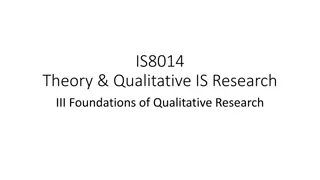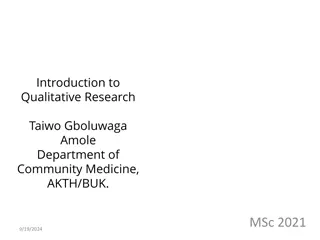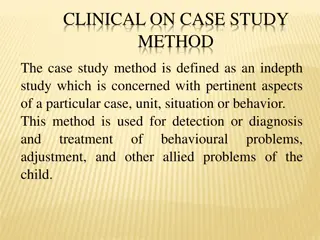Understanding the Case Study Method: In-depth Qualitative Analysis
The case study method is a popular form of qualitative analysis involving intensive observation of a social unit. It focuses on detailed analysis of a limited number of events or conditions to understand complex interrelationships. Characteristics include intensive study of a single unit, qualitative approach, and fruitful hypothesis generation. Evolution and scope show wide usage in various disciplines.
Download Presentation

Please find below an Image/Link to download the presentation.
The content on the website is provided AS IS for your information and personal use only. It may not be sold, licensed, or shared on other websites without obtaining consent from the author. Download presentation by click this link. If you encounter any issues during the download, it is possible that the publisher has removed the file from their server.
E N D
Presentation Transcript
CASE STUDY METHOD THE CASE STUDY METHOD IS A VERY POPULAR FORM OF QUALITATIVE ANALYSIS AND INVOLVES A CAREFUL AND COMPLETE OBSERVATION OF A SOCIAL UNIT, BE THAT UNIT A PERSON, A FAMILY, AN INSTITUTION, A CULTURAL GROUP OR EVEN THE ENTIRE COMMUNITY. IT IS A METHOD OF STUDY IN DEPTH RATHER THAN BREADTH. THE CASE STUDY PLACES MORE EMPHASIS ON THE FULL ANALYSIS OF A LIMITED NUMBER OF EVENTS OR CONDITIONS AND THEIR INTERRELATIONS. THE CASE STUDY DEALS WITH THE PROCESSES THAT INTERRELATIONSHIP. THUS, CASE STUDY IS ESSENTIALLY AN INTENSIVE INVESTIGATION OF THE PARTICULAR UNIT UNDER CONSIDERATION. THE OBJECT OF THE CASE STUDY METHOD IS TO LOCATE THE FACTORS THAT ACCOUNT FOR THE BEHAVIOUR-PATTERNS OF THE GIVEN UNIT AS AN INTEGRATED TOTALITY.+ TAKE PLACE AND THEIR
Characteristics The important characteristics of the case study method are as under: Under this method the researcher can take one single social unit or more of such units for his study purpose; he may even take a situation to study the same comprehensively. 1. Here the selected unit is studied intensively i.c., it is studied in minute details. Generally, the study extends over a long period of time to ascertain the natural history of the unit so as to obtain enough information for drawing correct inferences. 2. In the context of this method we make complete study of the social unit covering all facets. Through this method we try to understand the complex of factors that are operative within a social unit as an integrated totality. 3. Under this method the approach happens to be qualitative and not quantitative. Mere quantitative information is not collected. Every possible effort is made to collect information concerning all aspects of life. As such, case study deepens our perception and gives us a clear insight into life. For instance, under this method we not only study how many crimes a man has done but shall peep into the factors that forced him to commit crimes when we are making a case study of a man as a criminal. The objective of the study may be to suggest ways to reform the criminal. 4.
Characteristics In respect of the case study method an effort is made to know the mutual inter-relationship of causal factors. 5. Under case study method the behaviour pattern of the concerning unit is studied directly and not by an indirect and abstract approach. 6. Case study method results in fruitful hypothesis along with the data which may be helpful in testing them, and thus it enables the generalised knowledge to get richer and richer. In its absence, generalised social science may get handicapped. 7.
Evolution and scope The case study method is a widely used systematic field research technique in sociology these days. The credit for introducing this method to the field of social investigation goes to Frederic Le Play who used it as a hand-maiden to statistics in his studies of family budgets. Herbert Spencer was the first to use case material in his comparative study of different cultures. Dr. William Healy resorted to this method in his study of juvenile delinquency, and considered it as a better method over and above the mere use of statistical data. Similarly, anthropologists, historians, novelists and dramatists have used this method concerning problems pertaining to their areas of interests. Even management experts use case study methods for getting clues to several management problems. In brief, case study method is being used in several disciplines. Not only this, its use is increasing day by day.
Assumptions The case study method is based on several assumptions. The important assumptions may be listed as follows: The assumption of uniformity in the basic human nature in spite of the fact that human behaviour may vary according to situations. The assumption of studying the natural history of the unit concerned. The assumption of comprehensive study of the unit concerned.
Major phases involved: Major phases involved in case study are as follows: Recognition and determination of the status of the phenomenon to be investigated or the unit of attention. (i) Collection of data, examination and history of the given phenomenon. (ii) (iii) Diagnosis and identification of causal factors as a basis for remedial or developmental treatment. (iv) Application of remedial measures i.e., treatment and therapy (this phase is often characterised as case work). Follow-up programme to determine effectiveness of the treatment applied. (v)

























